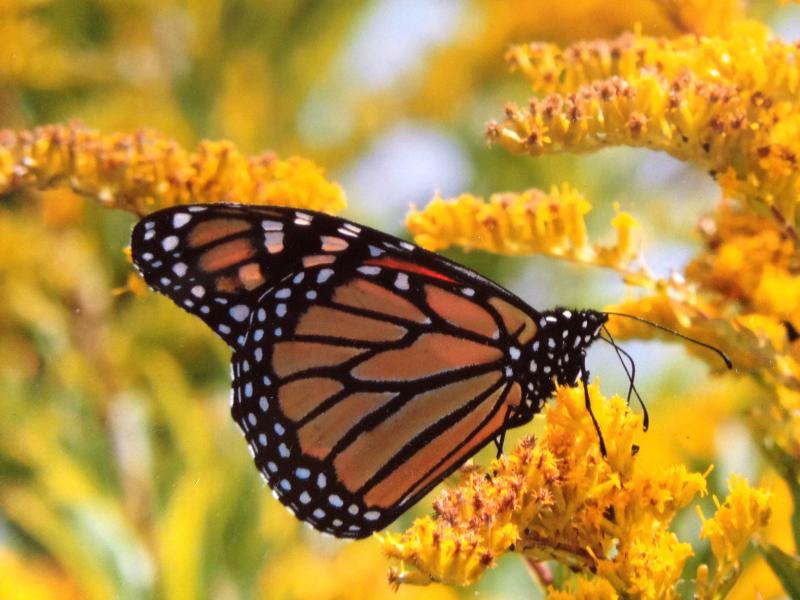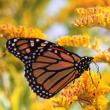Tough Bugs and the Birds That Want to Eat Them
When the sharp blue-sky days of September begin here in Maine, many people start looking for a beautiful orange and black creature with wings. Nope, not a bird. We are referring to the monarch butterfly. We have heard that in many areas, people are seeing more monarchs than in the last few years, which would be good news for this declining species.
Monarchs are famous for the epic fall migration of northern populations to Mexico for the winter. After overwintering the monarchs migrate to the southern U.S. in the spring where they lay their eggs before they die. When their offspring become butterflies, they fly farther north and lay their eggs. This continues for several generations over the summer until by late summer some have reached the northern U.S. and southern Canada. This last generation of the summer are the individuals that then migrate south to Mexico to overwinter and start the cycle again in the spring.
But monarchs are also famous for something involving birds. As many people know, milkweeds are the host plants of monarchs. The female butterflies lay their eggs on the milkweeds and after hatching, the caterpillars feed on the plant until they form a chrysalis and transform into a butterfly. If you’ve ever broken off a milkweed leaf, you will know that they exude a milky sap. Compounds in that sap keep most insects and also mammalian herbivores like deer and cows from eating the plant. But monarchs have evolved a way to handle the nasty, bitter compounds and sequester them away in their body so that they are not bothered by them. Back in the 1960s, a biologist named Lincoln Brower did experiments in which he offered captive blue jays adult monarch butterflies that had, while caterpillars, fed on some types of milkweed with particularly toxic compounds. Most biology textbooks today show some of the photos Brower took during the experiment that show blue jays vomiting up the monarchs that they had eaten. When offered another monarch, not surprisingly, the blue jays would not eat it.
In the wild, some monarchs are apparently not quite as full of these bitter and noxious compounds as others because the level of the compounds varies from one species of milkweed to another and even from one population of milkweeds to another. So some birds can and do eat monarchs, at least until they encounter one that makes them sick!
There are lots of fascinating insects that have evolved ways to make them less likely to become bird food. Some caterpillars have hairs, including some whose hairs cause irritations to eyes and skin. Those of you who have had an encounter here in Maine with the brown-tailed moth may know from experience what that is like. While we don’t specifically know about brown-tailed moths, some birds do eat hairy caterpillars, typically beating the caterpillar against a limb, apparently to knock off the hairs. Black-billed and yellow-billed cuckoos are said to be avid consumers of tent caterpillars and other hairy caterpillars. A yellow-billed cuckoo was once documented consuming over 100 tent caterpillars in one session!
One of the more interesting examples of birds eating insects that are normally avoided comes from the tanagers. Wasps and bees are avoided by most creatures—including humans and birds. But some tanagers specialize in catching bees and wasps. They hold them in the bill, then hit the stinger end on to a branch to remove it, then swallow the insect down. Although summer tanagers (the all-red tanager of the southern U.S. that only rarely is found in Maine) are the most well-known for this, scarlet tanagers (the black-winged species that commonly nests in Maine) also sometimes engage in this type of feeding behavior.
We hope you get to enjoy seeing some monarch butterflies this fall — and imagining a bird’s reaction to eating one!
Jeffrey V. Wells, Ph.D., is a Fellow of the Cornell Lab of Ornithology. Dr. Wells is one of the nation's leading bird experts and conservation biologists and author of the “Birder’s Conservation Handbook.” His grandfather, the late John Chase, was a columnist for the Boothbay Register for many years. Allison Childs Wells, formerly of the Cornell Lab of Ornithology, is a senior director at the Natural Resources Council of Maine, a nonprofit membership organization working statewide to protect the nature of Maine. Both are widely published natural history writers and are the authors of the book, “Maine’s Favorite Birds” and the just-released “Birds of Aruba, Bonaire, and Curaçao” from Cornell University Press.
Event Date
Address
United States




































